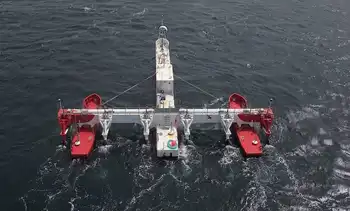Tidal-power research under way
By Knight Ridder Tribune
NFPA 70e Training
Our customized live online or in‑person group training can be delivered to your staff at your location.

- Live Online
- 6 hours Instructor-led
- Group Training Available
The Snohomish County Public Utility District and the University of Washington are waiting for results from ongoing acoustic Doppler testing at Admiralty Inlet and Deception Pass. The PUD is considering how well each site might perform as a tidal-power location, while the UW hopes to use the information to continue mapping tidal flows throughout Puget Sound.
About two weeks ago, the two began collecting data, and it won't be until mid-September that enough information has been collected to start giving them a sense of how the waters move through both areas. Admiralty Inlet, about three miles wide, could be the PUD's best option for a tidal-power plant, says Craig Collar, the PUD's senior manager of energy-resource development.
But fast currents at Deception Pass make it too good not to study, despite other problems at the location, he said. "We're looking for strong, predictable tidal currents," Collar said. "Deception Pass, while having the highest current in Puget Sound, could be too turbulent."
Plus, environmental and aesthetic concerns would force the PUD to reconcile with several parties, including the state of Washington, before any tidal plant would be built at the state park. The PUD is counting on adding tidal power to its array of energy production in light of Initiative 937, which requires a mix of conservation measures and renewable-energy sources to make up a utility's energy base.
Under the initiative, utilities serving more than 25,000 customers - the PUD has more than 300,000 - need to get at least 15 percent of their energy from renewable resources, not including hydropower, by 2020. The PUD also needs to meet new energy needs associated with continued growth in Snohomish County.
"We estimate we'll need to add 140 average megawatts by 2020," Collar said. That's enough power for about 100,000 more homes. The seven sites scheduled for tidal-power testing could produce about 100 megawatts, according to the PUD's federal permit applications. The acoustic Doppler tests are the first completed to see how useful a location might be in providing enough wave energy to turn underwater propellers attached to turbines.
The PUD will do one round of testing this year at Admiralty Inlet and Deception Pass, then test five more sites sometime next year. Those sites are at Speiden Channel and San Juan Channel off San Juan Island, Guemes Channel near Anacortes, and Agate Passage and Rich Passage along Bainbridge Island. The first Doppler testing was done by boat and measured how tidal currents bounce off the shoreline at each site. Now, stationary devices have been placed in the water to measure currents over the course of a month. It's this long-term data that interests UW researchers as they develop a model of tidal currents throughout Puget Sound.
"Anytime you're modeling something as complex as Puget Sound, you like to have measurements to verify that modeling," said Philip Malte, a UW mechanical-engineering professor. "We're getting an initial impression now, and then as we begin to look more deeply at the data we should learn quite a bit quickly."
Ocean currents are continually shifting, so to be successful in its modeling, the UW needs to see how measurements change over time. The stationary tests will measure two tidal cycles. After tidal testing, if sites prove to have potential, the PUD will study the economics of operating tidal-power plants at those locations and begin to look at available technologies and conduct environmental tests.
The field of tidal energy is relatively new in the United States, and much will need to be done to get federal approval for any power plant, Collar said. Any tidal-power plant run by the PUD is still years away, he said.
"These are the Kitty Hawk days for tidal energy," he said, referencing the Wright Brothers' initial airplane flight in 1903. "There are still many questions to be answered."











